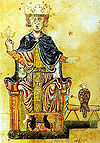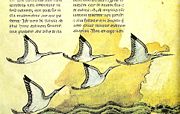
De arte venandi cum avibus
Encyclopedia

Latin
Latin is an Italic language originally spoken in Latium and Ancient Rome. It, along with most European languages, is a descendant of the ancient Proto-Indo-European language. Although it is considered a dead language, a number of scholars and members of the Christian clergy speak it fluently, and...
treatise on ornithology
Ornithology
Ornithology is a branch of zoology that concerns the study of birds. Several aspects of ornithology differ from related disciplines, due partly to the high visibility and the aesthetic appeal of birds...
and Falconry
Falconry
Falconry is "the taking of wild quarry in its natural state and habitat by means of a trained raptor". There are two traditional terms used to describe a person involved in falconry: a falconer flies a falcon; an austringer flies a hawk or an eagle...
written in the 1240s by Frederick II
Frederick II, Holy Roman Emperor
Frederick II , was one of the most powerful Holy Roman Emperors of the Middle Ages and head of the House of Hohenstaufen. His political and cultural ambitions, based in Sicily and stretching through Italy to Germany, and even to Jerusalem, were enormous...
, and dedicated to his son Manfred
Manfred of Sicily
Manfred was the King of Sicily from 1258 to 1266. He was a natural son of the emperor Frederick II of Hohenstaufen but his mother, Bianca Lancia , is reported by Matthew of Paris to have been married to the emperor while on her deathbed.-Background:Manfred was born in Venosa...
.
Frederick II was familiar with Aristotle
Aristotle
Aristotle was a Greek philosopher and polymath, a student of Plato and teacher of Alexander the Great. His writings cover many subjects, including physics, metaphysics, poetry, theater, music, logic, rhetoric, linguistics, politics, government, ethics, biology, and zoology...
's treatise on animals in Latin translation :Liber Animalum, a translation from the Arabic by Michael Scot
Michael Scot
Michael Scot was a medieval mathematician and scholar.- Early life and education :He was born in Scotland, and studied first at the cathedral school of Durham and then at Oxford and Paris, devoting himself to philosophy, mathematics, and astrology...
us his court astrologer. He was also familiar with De Scientia Venandi per Aves, a treatise by the Arab falconer Moamyn, it was translated into Latin at his court by Master Theodore of Antioch, and much copied.
It is notable that Frederick II mainly confides in his own observations and experiments: he experimented with eggs to see if they would hatch only by the warmth of the sun; he tried to find out if birds used their sense of smell while hunting by covering the eyes of vultures. The author keeps to his intention, formulated in the preface, to describe the things as they are (“que sunt, sicut sunt”). It is a scientific book, approaching the subject from Aristotle, whom he likes to contradict. At the same time it is a scholastic
Scholasticism
Scholasticism is a method of critical thought which dominated teaching by the academics of medieval universities in Europe from about 1100–1500, and a program of employing that method in articulating and defending orthodoxy in an increasingly pluralistic context...
book, minute and almost mechanical in its divisions and subdivisions.
The original manuscript of Frederick II was lost in 1248 at the siege of Parma.
Manuscripts of De arte venandi cum avibus exist in a two-book version (Manuscripts at Rome, Vienna, Paris (2x), Geneva and Stuttgart) and in a six-book version (Manuscripts at Bologna, Paris, Nantes, Valencia, Rennes, and Oxford).
The most famous copy of this treatise is an illuminated manuscript
Illuminated manuscript
An illuminated manuscript is a manuscript in which the text is supplemented by the addition of decoration, such as decorated initials, borders and miniature illustrations...
commissioned by his son Manfred, a two-column parchment
Parchment
Parchment is a thin material made from calfskin, sheepskin or goatskin, often split. Its most common use was as a material for writing on, for documents, notes, or the pages of a book, codex or manuscript. It is distinct from leather in that parchment is limed but not tanned; therefore, it is very...
codex
Codex
A codex is a book in the format used for modern books, with multiple quires or gatherings typically bound together and given a cover.Developed by the Romans from wooden writing tablets, its gradual replacement...
of 111 folios now in the Vatican Library
Vatican Library
The Vatican Library is the library of the Holy See, currently located in Vatican City. It is one of the oldest libraries in the world and contains one of the most significant collections of historical texts. Formally established in 1475, though in fact much older, it has 75,000 codices from...
in the Bibliotheca Palatina
Bibliotheca Palatina
The Bibliotheca Palatina of Heidelberg was the most important library of the German Renaissance, numbering approximately 5,000 printed books and 3,524 manuscripts....
The manuscript belongs to the two book version and is illustrated with brilliantly coloured, extraordinarily lifelike, accurate and minute images of birds, their attendants, and the instruments of the art. This manuscript contains additions made by Manfred, which are all clearly marked in the beginning by notations such as "Rex", "Rex Manfredus" or "addidit Rex".
The first translation of this work was in French and commissioned around 1300 by Jean II, lord of Dampierre., and the first translation into English (of the six-book version) was by Casey A. Wood and F. Marjorie Fyfe, as The Art of Falconry by Frederick II of Hohenstaufen (Stanford University Press) 1943.
The first printed edition of the Latin manuscript (the two-book version) was by Velser, Augsburg, 1596.

External links
- De arte venandi cum avibus, ScribdScribdScribd is a Web 2.0 based document-sharing website which allows users to post documents of various formats, and embed them into a web page using its iPaper format. Scribd was founded by Trip Adler, Tikhon Bernstam, and Jared Friedman in 2006...
- Preface

